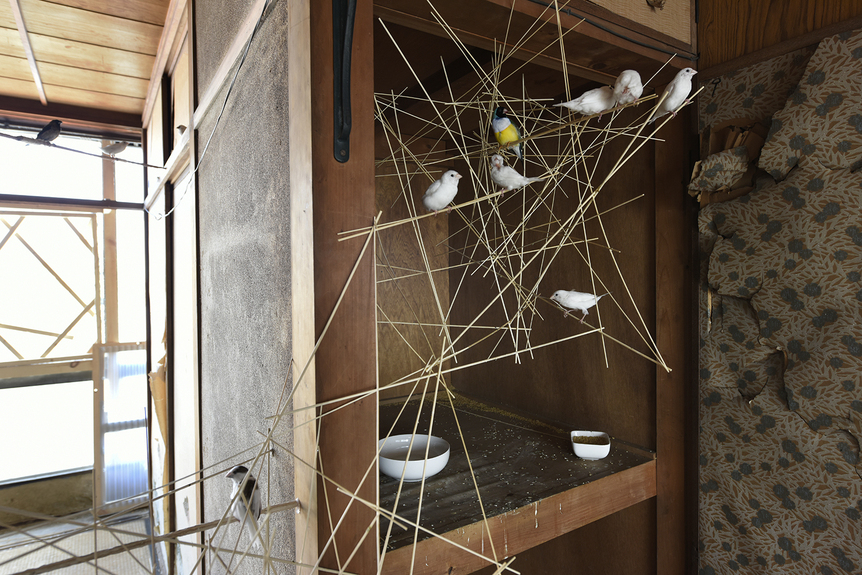-
From Current Issue
-
- Editor’s Letter Fire in the Heart
- Reviews I Gusti Ayu Kadek Murniasih
- Reviews 11th Seoul Mediacity Biennale: “One Escape at a Time”
- Dispatch Networked China
- One on One Monira Al Qadiri on Yukio Mishima
- Essays The rise of independent art spaces in pandemic-era Shanghai
- Features Tuan Andrew Nguyen
- Table of Contents
- Web Exclusives
- Archive
- Subscribe

R
E
V N
E
X
T
ALLORA & CALZADILLA, The Great Silence, 2014, three-channel HD video installation, 16 min, 22 seconds. Courtesy the artists.
In the center of Japan lies Aichi Prefecture, a titan of the automotive industry, and, as of the last nine years, the home of one of Japan’s largest art festivals—the Aichi Triennale. Drawing Japanese and international artists to the three cities of Nagoya, Okazaki and Toyohashi, the third iteration of the Triennale, entitled “Homo Faber: A Rainbow Caravan,” examines the history of human creativity and the different forms it takes today. Such an abstract and comprehensive theme may seem ambitious, with the potential to create a nebulous and vague product; however, the Triennale is anything but. Crafted under the purview of artistic director Chihiro Minato and an international team of nine curators, the festival features a group of 119 artists from 38 countries and a massive spectrum of work, of which a majority is new. The works touch upon all aspects of human creative potential, from the traditional to the novel.
Highlighting the rich culture of Aichi Prefecture, as well as human innovation and possibilities, the Triennale is spread not only over the museums of the three cities, but brings visitors to less conventional locations such as the Suijo Building—a five-story structure constructed over a canal in central Toyohashi. Here, Brazilian artist Laura Lima took over the commercial building to create her installation Flight (2008/2016), a beautiful and functional human-sized bird habitat, in which visitors become guests in the birds’ home, reversing the human-animal relationship. Nearby in Hazama Building Ohba, epitomizing the creative and thoughtful curation of the Triennale and contrasting the calm coexistence created by Lima, is the music-based installation of Libidiunga Cardoso (a.k.a. Leandro Nerefuh). Entitled Eclipse Phenomenon (2016), the work allows visitors to become the DJ and control the atmosphere in the room.
Similar to the clever use of the Suijo Building to integrate visitors into the history of the city is the utilization of the former Meidi-ya Sakae Building in Nagoya. The latter, an abandoned department store, plays host to different artists on each of its three stories, drawing the visitor through the architectural shell. As visitors travel up through the building they transition through three very different environments, beginning with the large, bright psychedelic paintings of Kerstin Brätsch in the light and spacious ground floor. The second level, devoid of natural light, boasts a contrastingly spooky installation, Liquids turn into gas by thermal energy, then get cold and turn back into a liquid. This is how it should be. (2016) by Satoshi Hata, which uses bright lights to create steam from pools of water that then condenses and drips back down, creating a dark and intimate cycle. On part of the third floor, Shuko Terada assembles various objects that each play with light in some way. Reflecting off mirrors and traveling through colored glass, light dances across the walls and the visitors. Bringing life to the abandoned building, the installations create dynamic environments integrating visitors into the continuing history of the venue.
SATOSHI HATA, Liquids turn into gas by thermal energy, then get cold and turn back into a liquid. This is how it should be., 2016, mixed-media installation, dimensions variable. Photo by ITO Tetsuo. Courtesy the artist.
The large variety of techniques and mediums used in the works of the Triennale speaks to the accurate realization of the festival’s theme of exploring the boundaries of humanity’s creative abilities. For example, Puerto Rican collaborative unit Allora & Calzadilla’s three-channel video, The Great Silence (2014), creates an emotional narrative using a first-person hypothetical message from a near-extinct species of parrot saying goodbye to its destroyer, humans. In one standout piece, The First Path (2016), Japanese artist Ai Sasaki uses white royal icing to create an intricate and massive monochromatic mural, causing viewers to consider what other mundane materials could be used as art.
While works from all three cities integrate with the local infrastructure, Okazaki has one amenity that the other two cities lack—complimentary bicycles for the attendees. Unlike walking or driving around a city, biking is an easier and more immersive way of experiencing the city, which is remarkably flat. Armed with a map, bike locks, and an attachable light (with extra batteries), visitors are free to spend the day cruising around the friendly city and taking in not only the artworks, but also the atmosphere and attitude of the more intimate aspects of Okazaki. Even though this mode of travel in Okazaki is by far the most fun among the three cities, the choice and layout of venues and the thoughtful curation of the works in all three locations of the Aichi Triennale transforms each into a fascinating journey dissecting the past, present and potential future of human creativity.
Aichi Triennale 2016 is currently on view at various locations around the Aichi Prefecture until October 23, 2016.





